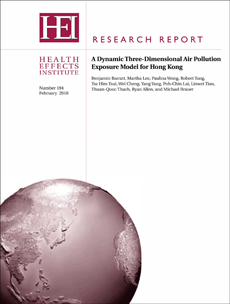You are here
Developing a dynamic 3D exposure model for air pollution in Hong Kong
 With rapid urbanization, high-density, high-rise megacities have become very common globally. So far, models to estimate exposure to air pollution have been largely two-dimensional. HEI’s Research Report 194, A Dynamic Three-Dimensional Air Pollution Exposure Model for Hong Kong, describes a study led by Benjamin Barratt of King’s College London, United Kingdom, that developed a dynamic three-dimensional land-use regression model for Hong Kong and used it to estimate exposure to traffic-related air pollution. The investigators developed different exposure models with increasing complexity (e.g., incorporating infiltration of outdoor pollutants, vertical gradients, and time–activity patterns). Those models were applied in an epidemiological study using an existing elderly cohort of 66,000 Hong Kong residents to evaluate the potential impact of exposure measurement error on mortality estimates.
With rapid urbanization, high-density, high-rise megacities have become very common globally. So far, models to estimate exposure to air pollution have been largely two-dimensional. HEI’s Research Report 194, A Dynamic Three-Dimensional Air Pollution Exposure Model for Hong Kong, describes a study led by Benjamin Barratt of King’s College London, United Kingdom, that developed a dynamic three-dimensional land-use regression model for Hong Kong and used it to estimate exposure to traffic-related air pollution. The investigators developed different exposure models with increasing complexity (e.g., incorporating infiltration of outdoor pollutants, vertical gradients, and time–activity patterns). Those models were applied in an epidemiological study using an existing elderly cohort of 66,000 Hong Kong residents to evaluate the potential impact of exposure measurement error on mortality estimates.

